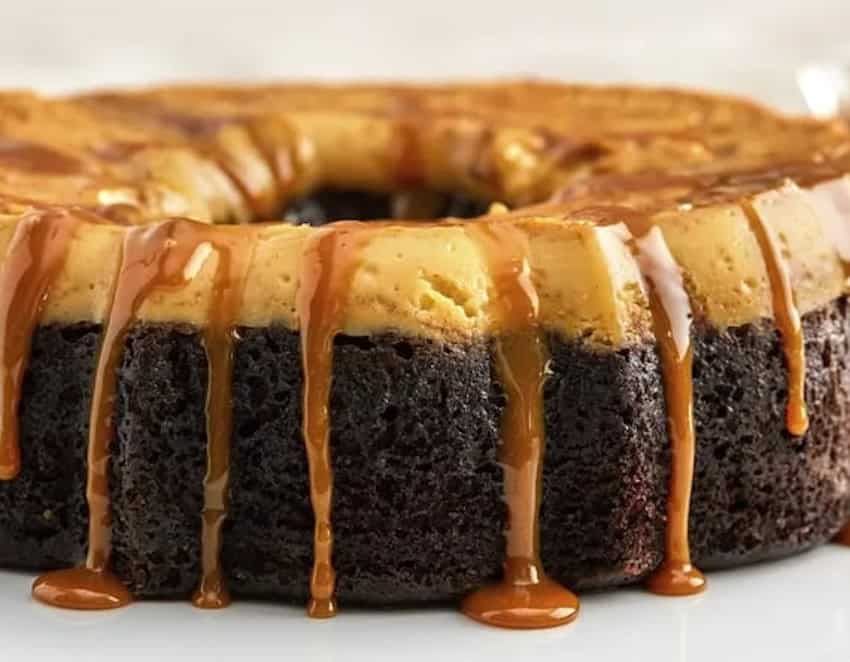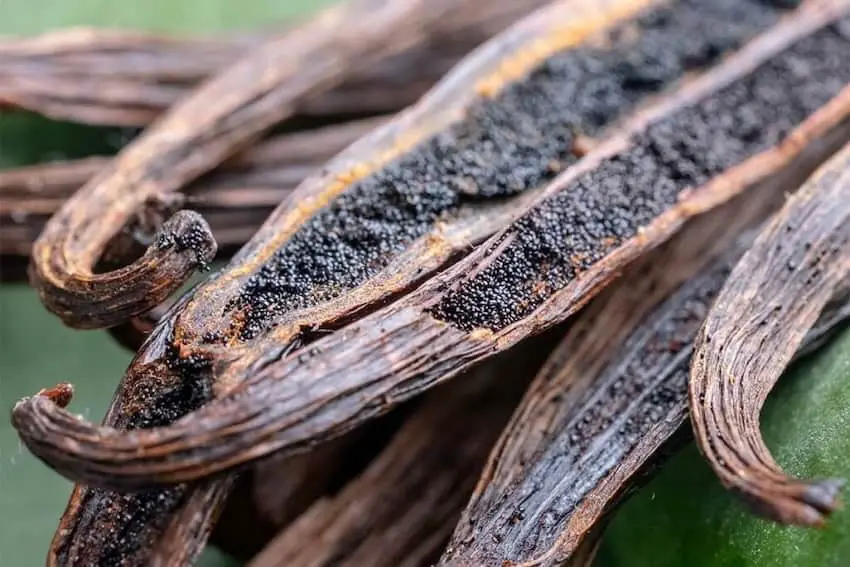When researching trending desserts in the United States, I was shocked to see chocoflan touted in both Taste Tomorrow and Bake Magazine as a rising star in the dessert world. The former publication stated that chocoflan is now one of the top trends in the patisserie industry, “reflecting a consumer interest in innovative and nostalgic desserts.”
I was surprised on several accounts. First, I didn’t know chocoflan was Mexican and second, I didn’t realize this “impossible” cake — as it’s known — was such a novelty. Please don’t let me scare you! It is not impossible to make: it’s the way it bakes that defies logic!

Chocoflan is composed of three layers. The first is caramel. In the vintage version, this caramel, called cajeta, was made from goat’s milk, which adds superior richness to the cake. The second layer is chocolate cake; the third is flan. But the amazing thing is this: when the layers bake, they reverse. The cake ends on the bottom and the flan rises to the top. The process has even been called “miraculous.”
Chocoflan originated in Mexico around the mid-20th century and is a staple of its celebrations and get-togethers. The recipe included here is from Mexican chef Edson Diaz-Fuentes. Before we jump in, let’s talk about the vanilla that’s used in this recipe. “At home in Mexico,” Díaz-Fuentes says, “we traditionally use vanilla from Papantla, Veracruz, the aroma and flavor of which is much appreciated around the world.” That’s because this famous vanilla — and all vanilla — originated in Mexico centuries ago.
It was the Totonac people of Mexico, in around the area that is now Veracruz, who first cultivated the vanilla orchid and processed it into vanilla, which they used for ritual and medicinal purposes. Then the Mexica came and conquered the Totonacs, adopting their methodology for making this sweet, aromatic “spice” — vanilla is considered a spice because it is generated from the pods of orchids. The eventual Spanish conquest of Mexico saw the exporting of vanilla to Europe, and the rest is history.
But there was a problem: vanilla could only be grown in Mexico because its pollination required the Melipona bee, the only known natural pollinator of the vanilla orchid. It wasn’t until the mid-1800s that artificial hand pollination was developed, which expanded the process of making vanilla to the tropical world. By the early 20th century, Madagascar was the world’s leading producer of vanilla, a position it retains today along with Indonesia. Vanilla production, however, continues to be a labor-intensive process, and vanilla is the second most expensive spice in the world, after saffron.

Authentic Mexican chocoflan
Ingredients
For the caramel
- 1 cup caster sugar (azúcar estándar). Caster sugar is superfine granulated sugar; to make, simply put granulated sugar in a food processor and give it a couple of pulses.
For the chocolate cake
- ¾ cup salted butter, softened, plus extra for the pan (mantequilla con sal)
- 1 cup caster sugar
- 2 eggs (huevos)
- 1 ¾ cups all-purpose flour (you may find that the all-purpose flour available in Mexico does not work as well, in which case you can order a familiar brand online)
- ½ cup cocoa powder (cacao en polvo)
- 2 tsp ground cinnamon (canela molida)
- ½ tsp baking powder (polvo para hornear)
- ½ tsp baking soda (bicarbonato de sodio)
- ½ cup buttermilk (¾ cup of sour cream plus ¼ cup milk will make 1 cup of buttermilk)
For the flan
- 1 ¼ cups condensed milk (leche condensada)
- 1 cup evaporated milk (leche evaporada)
- ½ cup cream cheese (queso crema)
- 3 eggs
- 1 tbsp vanilla extract (extracto de vainilla). Mexican brands: Villa Vainilla, Vainilla Totonac, Molina Vainilla.
For the garnish
- ½ cup cacao nibs, crushed (semillas de cacao)
- 1 tbsp puffed amaranth (amaranto)
- 1 ¼ tbsp toasted pumpkin seeds (semillas de calabaza)
- Optional: crushed ancho chili flakes (hojuelas de chile ancho trituradas)
Instructions
Prep
- Heat the oven to 200 C (392 F), or 180 C (356 F) for a gas oven.
- Butter and breadcrumb a large bundt pan, about 2.5 liters or 9 cups in volume. Use breadcrumbs instead of flour for easy release.
- Select a deep roasting pan to use as a bain-marie (water bath). It should be deep enough to accommodate the cake pan. Pour enough water into the pan to come halfway up the sides.
- Put the roasting pan in the middle shelf of the oven while it preheats.
Making the caramel
- Put the caster sugar and 1/4 cup of water into a pan and stir to dissolve for 1 minute. Once dissolved, don’t stir again.
- Cook over a medium-high heat for a few minutes until it turns a deep golden color.
- Pour into the base of the bundt pan.
Making the chocolate cake
- Use a stand mixer to cream the butter and sugar for 5 minutes until light and fluffy.
- Add eggs and mix for a further 2 minutes until well combined.
- Add dry ingredients in small portions, alternating with the buttermilk.
- Once everything is well incorporated, put the cake batter into a piping bag and set aside. To make a piping bag, pour batter into a zip-lock or sandwich bag. Squeeze batter into the corner of the bag. When ready to use, snip the corner of the bag diagonally. The size of the snip will determine how much batter is released.
Making the flan
- Put all ingredients into a blender and mix on high speed for 2-3 minutes or until well combined.
- Set aside.
Assembling the chocoflan
- Pipe the cake batter into the cake pan, covering the caramel you added earlier.
- Level using a rubber spatula.
- Pour the flan mixture on top of the cake batter.
- Cover the cake pan with foil and put it in the bain-marie (water bath). If you need to, pour additional hot water into the roasting pan. It should come halfway up the sides of the pan.
- Bake for 35-40 minutes or until the cake mixture has floated to the top of the pan.
- Test by inserting a sharp knife into the deepest parts of the cake. It should come out clean. If not, bake for another 5-10 minutes.
- Remove the cake from the bain-marie (water bath) and let it cool completely before taking it out of the pan. Shake the pan in circular movements to loosen any points of cake that stick to the pan around the edges.
- Garnish with chopped toasted pumpkin seeds, toasted amaranth and cacao nibs.
- Adding a touch of crushed ancho chili flakes will add a different dimension.
Did this chocoflan recipe work for you? Make any changes? Let us know in the comments below.
Deborah McCoy is the one-time author of mainstream, bridal-reference books who has turned her attention to food, particularly sweets, desserts and fruits. She is the founder of CakeChatter and the author of four baking books for “Dough Punchers” via CakeChatter (available @amazon.com). She is also the president of The American Academy of Wedding Professionals.
